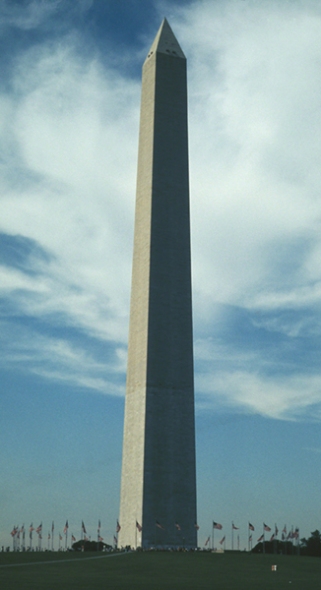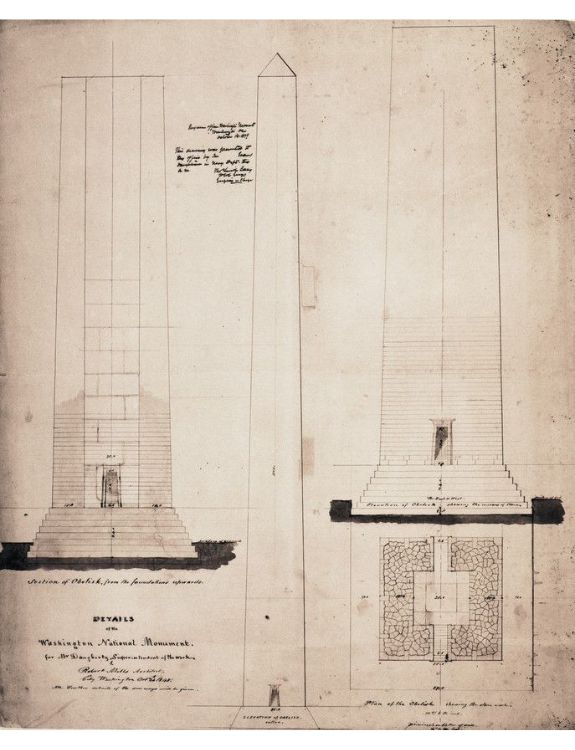This Day in (art) History: Dedication of the Washington Monument
Mills based his design on the elegant simplicity of the rectangular ancient Egyptian obelisks, with a circular base which was to be the colonnaded pavilion. Such obelisks had served similar functions, memorializing great rulers.
This day in (art) history, 21 February 1885: Dedication of the Washington Monument, Washington, DC
The Monument to the first president of the United States was dedicated by then President Chester A. Arthur (1829–1886). 2025 marks the 180th anniversary of the commission for the monument.
 |
| Robert Mills (1781–1855), Washington Monument, Washington, DC, 1848–1885. Image © 2025 Davis Art Images. (8S-6863) |
The cornerstone was laid in 1848. Mills died in 1855, and construction was not recommenced until 1876. At that time, the plans for the circular pavilion base were eliminated. Mills' simple plan reflects the same type of restrained Neoclassicism seen in his other Washington buildings. Mills' original height of 600 feet was reduced to 555 to reflect the ancient Egyptian idea of the height of an obelisk being ten times the width of the base (55 feet). It is the highest masonry tower in the world. When it was completed in 1884, the summit was capped in aluminum, a pioneering material at the time.
During the first three decades of the 1800s, there was a great desire on the part of Congress to create a monument to George Washington (died 1799), considered the father of the American Republic. A national monument was authorized by Congress in 1833. It was intended to be a monumental tower, much like the memorial columns in ancient Rome, which would include a colonnade at the base containing memorial statues of Revolutionary heroes. The competition for designing the monument was held in 1845 under President James K. Polk (1795–1849).
Robert Mills was born in Charleston, SC. In 1800 he moved to the new capital city of the US, Washington, DC, to work under James Hoban (ca. 1758–1831) on his design for the White House. In Washington, Mills became acquainted with Thomas Jefferson (1743–1826) who lent him books on European architecture. In 1803 Jefferson helped place Mills in the office of another capital architect Benjamin Latrobe (1764–1820), who had helped design the Capitol. Latrobe’s civil engineering work and his interpretation of ancient Greek and Roman architecture had a lasting impact on Mills’ designs.
In 1814 Mills won a competition to design a monument to the first president for Baltimore, MD, the first monument dedicated to Washington. Mills’ knowledge of old and modern European architecture enabled him to draw freely from European monuments for inspiration. The rounded, columnar, 178 foot high monument in Baltimore was loosely based on the ancient Roman Column of Trajan (113–116 CE). He subsequently design several monuments to other heroes of the Revolution based on the square, ancient Egyptian obelisk form, which, in essence, were his practice works for subsequent designs for the Washington Monument and National Mall in Washington.
Mills proposed several architectural monuments in Washington’s memory following his return to Washington, DC in 1830, but it was not until 1845 that he secured the commission for the Washington Monument. He also designed the National Mall (1841), an assemblage of gardens in different styles, which were part of Mills’ vision of the capital city as a city-wide museum of architecture and taste. His many architectural and engineering projects in the capital brought him the title of “unofficial Federal architect.”
 |
| Robert Mills, Details of the Washington Monument for Mr Daugherty, Superintendaen of the Work, Washington, DC, October 24, 1848. Ink drawing on paper, 23.8 x 36.6 cm. Courtesy of Historic New England, Boston. |

Comments